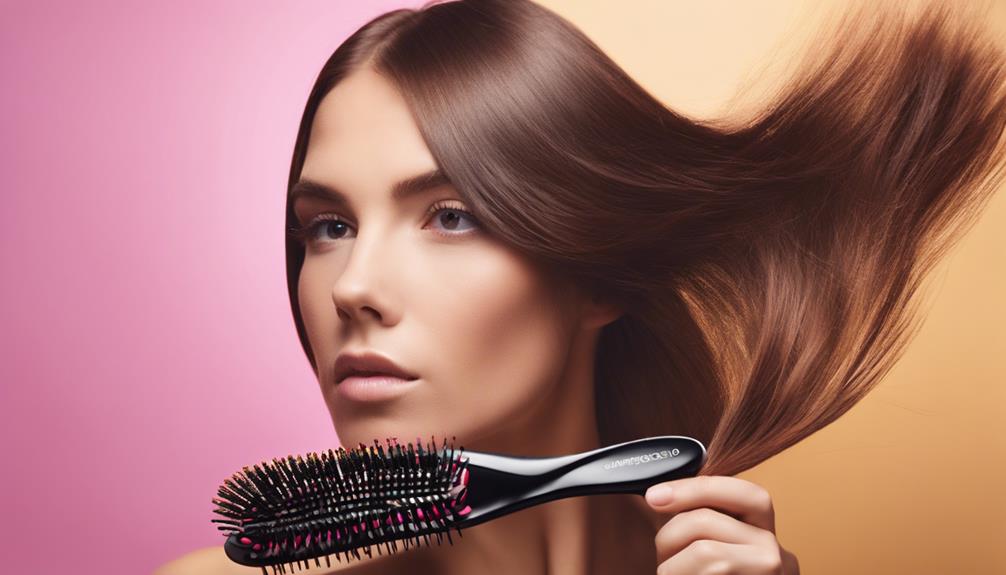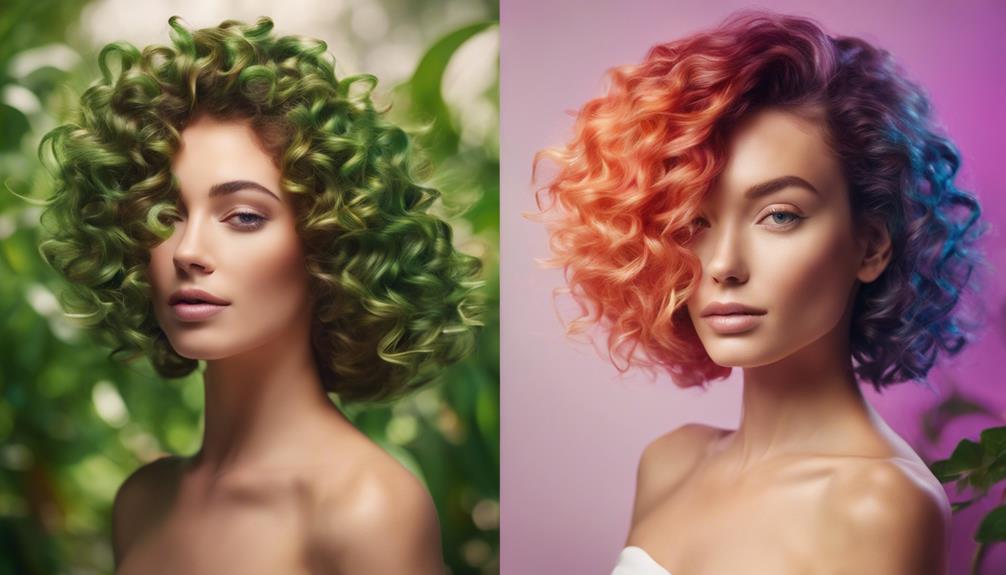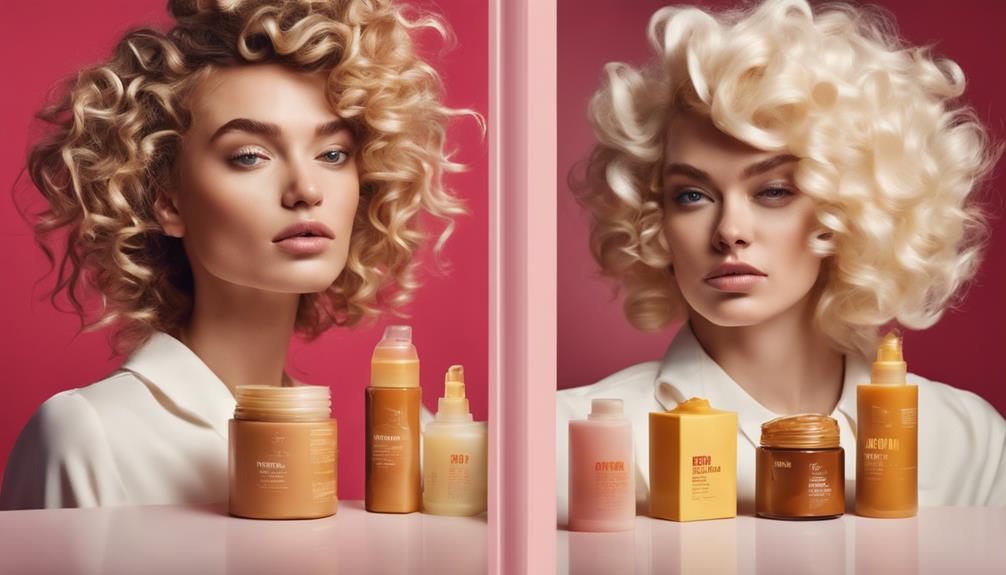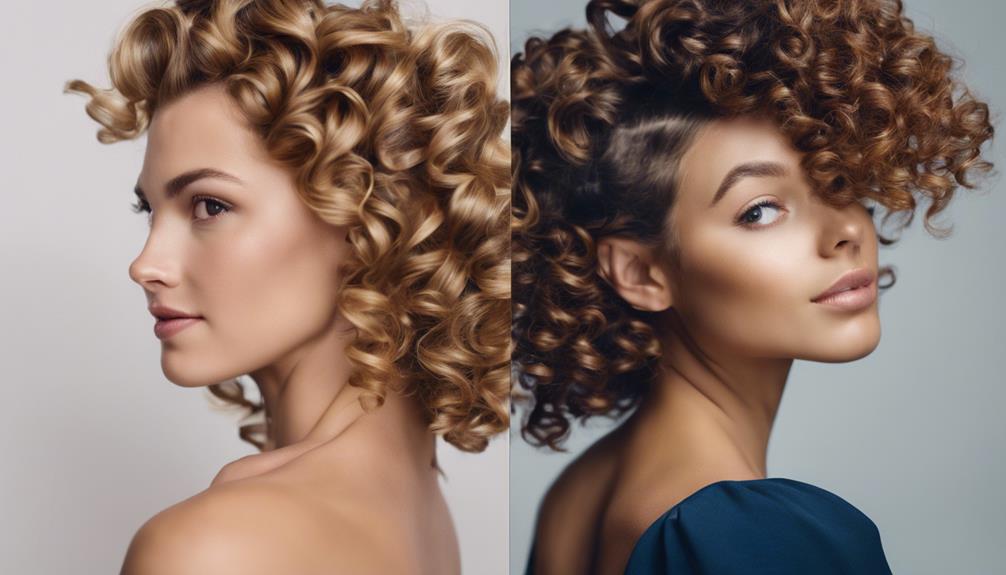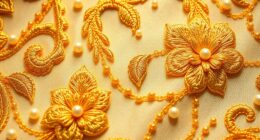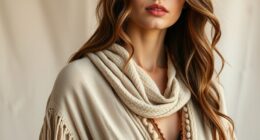When you're deciding between a detangling brush and a styling brush, think about your hair's needs. A detangling brush is perfect for gently removing knots, especially if your hair's fine or wet. It helps minimize breakage and promotes overall hair health. On the other hand, a styling brush enhances volume and controls frizz, ideal for medium to thick hair. If you want to achieve salon-quality styles, a styling brush is your go-to. Assess your hair type and what you want to achieve for the best choice. There's more to explore about each brush's benefits and features that could help you!
Key Takeaways
- Detangling brushes are ideal for gently removing knots and minimizing breakage, suitable for all hair types, especially fine or wet hair.
- Styling brushes enhance volume and control frizz, designed for shaping hairstyles, mainly effective on medium to thick hair.
- Choose a detangling brush for daily use to maintain hair health and prevent knots, particularly for easily tangled hair.
- Opt for a styling brush when looking to create specific hairstyles, curls, or added volume during styling sessions.
Understanding Detangling Brushes
Detangling brushes are essential tools designed to gently remove knots and minimize hair breakage, making them perfect for all hair types, especially fine or wet hair.
When you're detangling hair, using the right brush for your hair can make all the difference. Unlike regular brushes, detangling brushes feature flexible bristles that glide through tangles, reducing pain and damage. This is especially important for natural hair and extensions, which can be more prone to breakage.
One popular option is the Wet Brush, known for its ability to tackle knots without tugging, making it ideal for sensitive scalps and kids. You'll find that regular use of a detangling brush can help maintain the integrity of your hair, promoting healthier strands over time.
If you're considering alternatives, a boar bristle brush can also be beneficial, as it distributes natural oils while detangling. However, for those challenging tangles, a dedicated detangling brush is your best bet.
Benefits of Styling Brushes
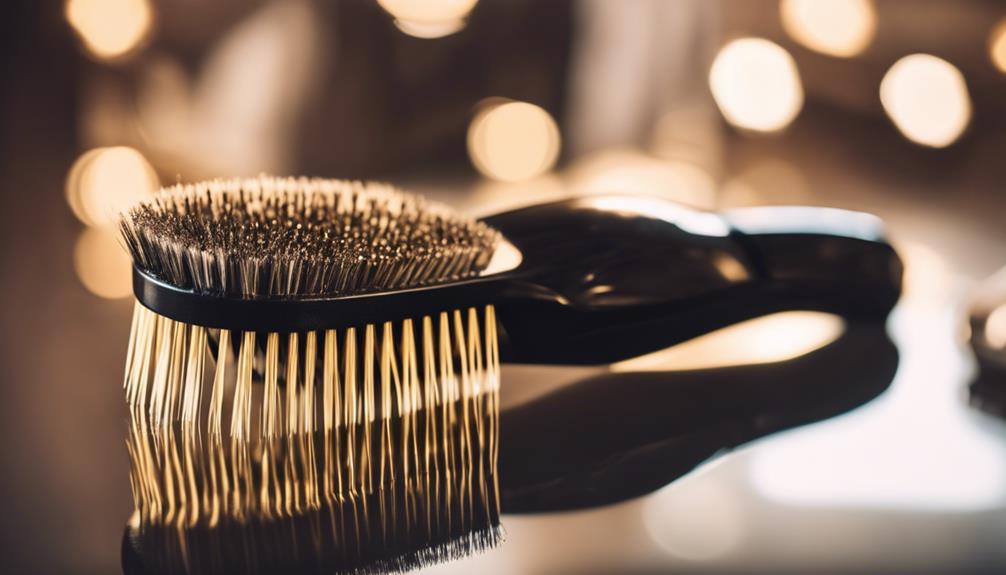
When you use styling brushes, you can enhance your hair's volume and achieve a polished look.
They also help control frizz and provide versatile styling options for any occasion.
With the right techniques, you'll notice a big difference in your hair's overall health and appearance.
Enhancing Hair Volume
A styling brush can greatly enhance your hair's volume, giving you that salon-finished look you desire. When you use styling brushes, particularly round ones, you can create bounce and fullness that's hard to achieve with other tools. These brushes often feature metal or ionic barrels that heat your hair as you style, which boosts volume while also reducing frizz for a smoother finish.
If you have medium to thick hair, consider using a paddle brush with mixed bristles, like natural boar and nylon. This combination offers better grip and control, allowing you to lift the roots effectively and create stunning volume.
Additionally, teasing brushes are essential for adding texture and height at the roots, making them a go-to for voluminous hairstyles without relying heavily on heat.
Smoothing and Frizz Control
How can styling brushes transform your hair into a sleek, frizz-free masterpiece? With their unique designs, styling brushes excel at smoothing hair and controlling frizz, making them indispensable in your hair care routine. By evenly distributing heat during blow-drying, they help seal the hair cuticle, resulting in a shiny finish.
| Brush Type | Benefits |
|---|---|
| Paddle Brush | Smooths and reduces frizz |
| Round Brush | Enhances shine and volume |
| Vented Brush | Promotes airflow, minimizing frizz |
Using brushes with metal or ionic barrels can greatly enhance frizz control, while boar bristle brushes effectively distribute natural oils, especially for fine or curly hair. Incorporating a vented brush speeds up drying time and prevents moisture buildup, further reducing frizz.
Regularly utilizing styling brushes not only helps maintain a polished look but also manages frizz effectively. You'll find that achieving that sleek, smooth hair you desire is much easier when you invest in the right styling brushes. So, why not give your hair the care it deserves?
Versatile Styling Options
Styling brushes offer a range of versatile options that elevate your hair game, allowing you to effortlessly create volume, curls, and sleek finishes. Unlike a detangling brush, which focuses primarily on removing knots, styling brushes are designed to enhance your styling process.
For instance, round brushes with metal or ionic barrels heat up during blow-drying, providing better hold and definition for curls or waves while reducing frizz. Paddle brushes are particularly versatile; they not only detangle but also smooth hair, making them ideal for straightening and prepping your locks for flat irons. If you're after instant volume and texture, teasing brushes can add lift at the roots, perfect for dynamic hairstyles.
Moreover, the choice of bristle type greatly impacts your styling results. Natural boar bristles work wonders for fine hair, while mixed bristles are great for thicker strands, promoting overall hair health.
Key Differences Explained
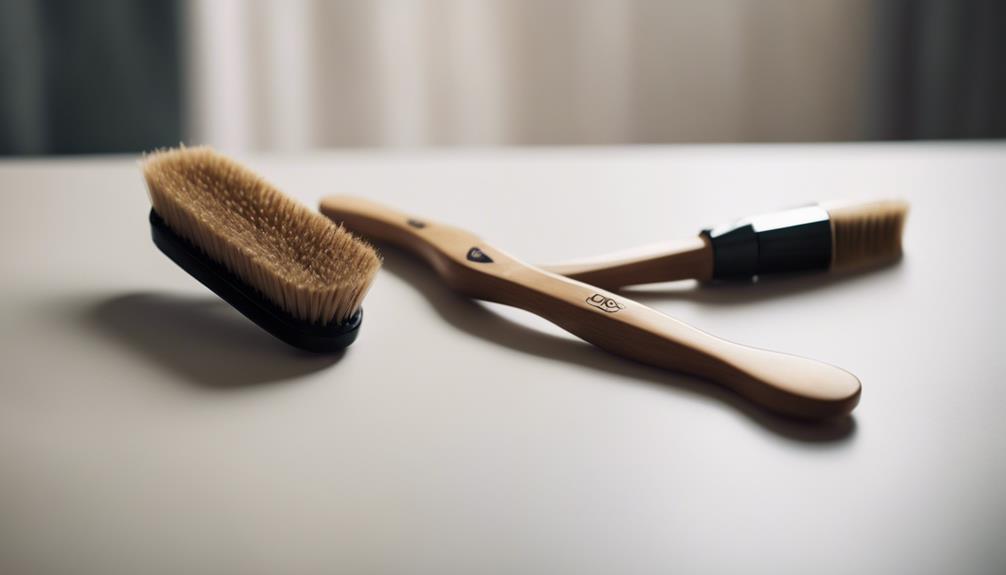
Understanding the key differences between detangling brushes and styling brushes can help you choose the right tool for your hair care routine.
Detangling brushes are specifically designed to gently remove knots and tangles without causing breakage, making them suitable for all hair types, especially fine or curly hair. Their flexible bristles minimize pulling, allowing you to use them on wet or dry hair daily.
On the other hand, styling brushes serve a different purpose. They're meant to shape, volumize, and smooth your hair during styling processes like blow-drying. Typically featuring firmer bristles, styling brushes create tension that helps control your hair, making them particularly effective for medium to thick hair types.
While detangling brushes are ideal for everyday use to maintain healthy hair, styling brushes are used mainly during styling sessions. Some detangling brushes can double as styling tools for quick touch-ups, but if you're aiming for specific hairstyles like curls or sleek looks, specialized styling brushes are often necessary.
Knowing these differences guarantees you select the right brush for your unique hair needs.
Choosing the Right Brush
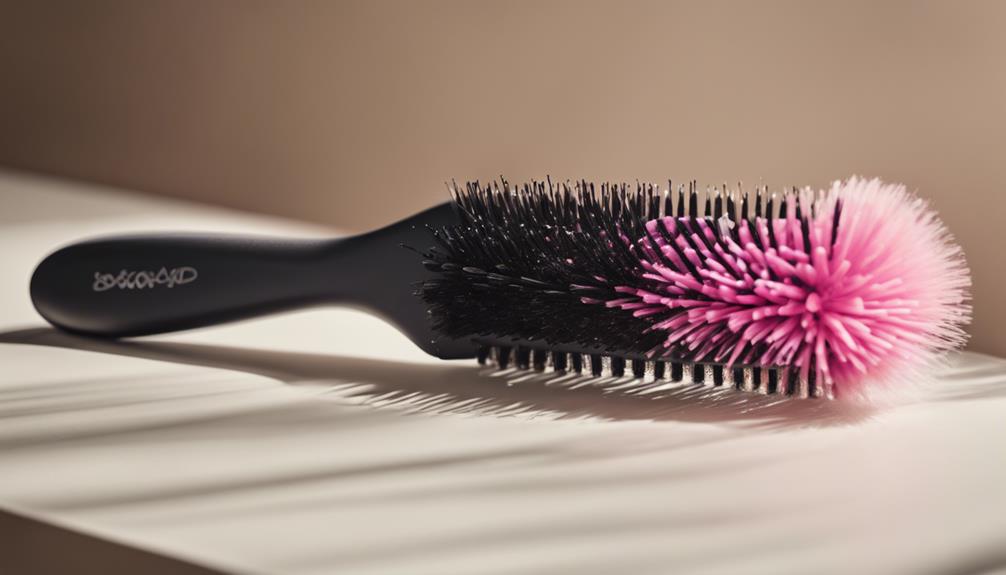
Selecting the right brush depends on your hair type and styling needs, ensuring you achieve the best results for your routine.
If your hair tends to tangle easily, you'll want to invest in a detangling brush. These brushes, like the Wet Brush, feature flexible bristles that minimize breakage and discomfort, making them perfect for daily use on wet or dry hair. Use a detangling brush after washing your hair to gently remove knots without causing damage.
On the other hand, if you're looking to style your hair, a styling brush is essential. These brushes, especially round ones, are designed for blow-drying and creating specific hairstyles, particularly for medium to thick hair. You'll use a styling brush during heat styling to add volume and shape, ensuring your final look is polished.
Remember to clean both types of brushes regularly to maintain their effectiveness. A detangling brush can accumulate hair and product buildup, while a styling brush may need residue removal.
Hair Types and Brush Compatibility

Different hair types require specific brushes to guarantee ideal detangling and styling results.
If you have fine or wet hair, opt for detangling brushes with flexible bristles that gently remove knots without causing breakage. On the other hand, if you have medium to thick hair, styling brushes like round or paddle brushes work best for shaping and smoothing during blow-drying.
Here's a quick guide to brush compatibility:
- Curly hair: Use wide-tooth combs when detangling while wet to minimize breakage and preserve your natural curl pattern.
- Fine hair: Choose boar bristle brushes, which help distribute natural oils and reduce frizz, enhancing shine without weighing your hair down.
Understanding your hair type and the right brushes to use can greatly impact your hair's health and appearance, helping you maintain those luscious locks effortlessly.
Techniques for Effective Detangling
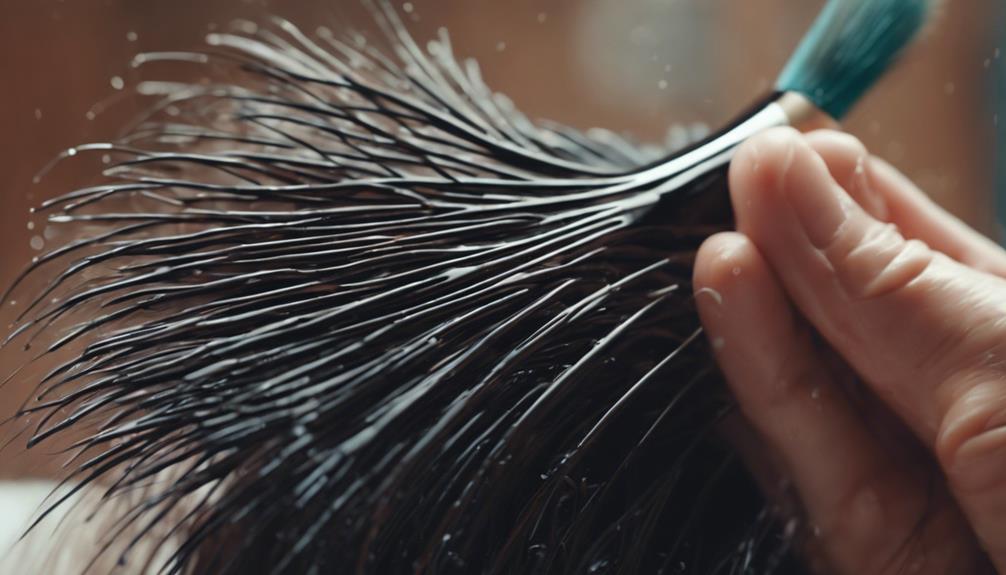
To detangle your hair effectively, start by sectioning it into smaller parts for better control.
Choosing the right products, like a leave-in conditioner or detangling spray, can also make a big difference in easing the process.
Sectioning Hair Properly
Properly sectioning your hair into manageable parts, typically 2-4 inches wide, makes detangling more effective and reduces the risk of breakage. This method allows you to focus on one area at a time, ensuring that you're gentle and thorough.
Start by using a wide-tooth comb or a detangling brush on wet hair, which helps minimize damage, especially for curly or textured strands.
Here are some tips for effective sectioning:
- Secure each section: Use clips or hair ties to hold sections in place, keeping your focus organized.
- Start from the ends: Always begin detangling from the tips and work your way up to the roots. This technique reduces pulling and discomfort.
Choosing Right Products
Selecting the right products for detangling can greatly enhance your hair care routine and minimize damage. Understanding your hair type is essential when choosing between a detangling brush and a styling brush. For finer or wet hair, a detangling brush like the Wet Brush works wonders, while thicker hair benefits from the smoothing capabilities of a paddle styling brush.
Here's a quick comparison to help you choose:
| Brush Type | Best For |
|---|---|
| Detangling Brush | Fine or wet hair |
| Styling Brush | Smoothing and shaping thicker hair |
| Teasing Brush | Adding volume (use sparingly) |
To maximize effectiveness, always start detangling at the ends of your hair and work your way up. This technique minimizes breakage. Incorporating conditioning products, such as a leave-in conditioner or a detangling spray, can create slip, making the process easier. If you use a styling brush, opt for those with ceramic or ion technology to reduce frizz and heat damage. Remember, follow up with a detangling brush after teasing to smooth out any tangles.
Styling Tips With Styling Brushes
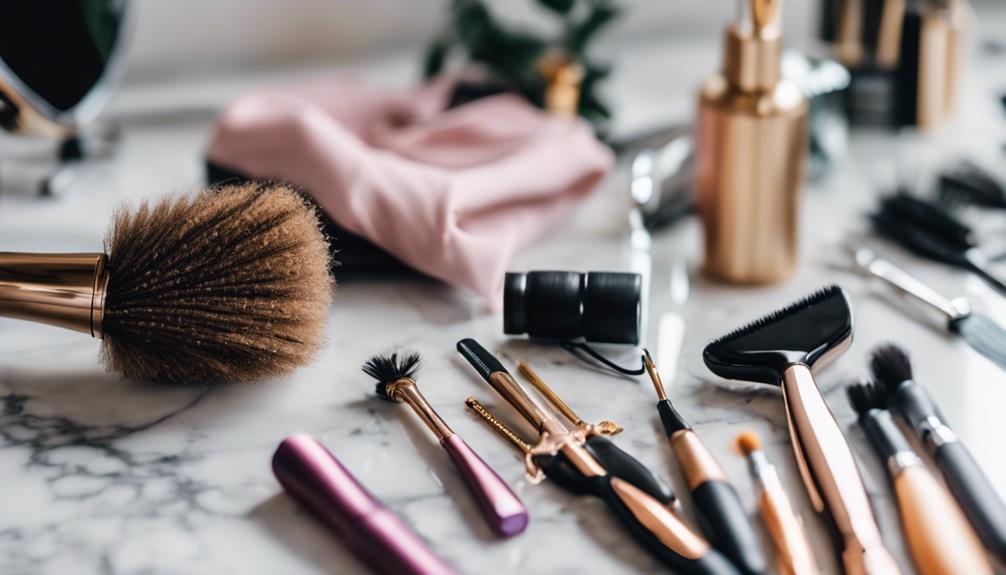
Using the right styling brush can greatly enhance your hair's volume and shine, making your styling routine more effective. When you choose the appropriate brush, you're not just detangling; you're also shaping and finishing your look.
Here are some tips to maximize your styling experience:
- Opt for round brushes: Use these to create volume and curls during blowouts. The mixed bristle design works wonders, especially if you have fine hair.
- Incorporate a vented brush: This brush allows for airflow, speeding up drying time while lifting the roots for added bounce.
Each brush serves a unique purpose, so experiment to find what works best for you.
Whether you're smoothing with a paddle brush or adding curls with a round brush, the right styling brushes can transform your look. Embrace these tips, and you'll notice a significant difference in how your hair looks and feels!
Product Recommendations
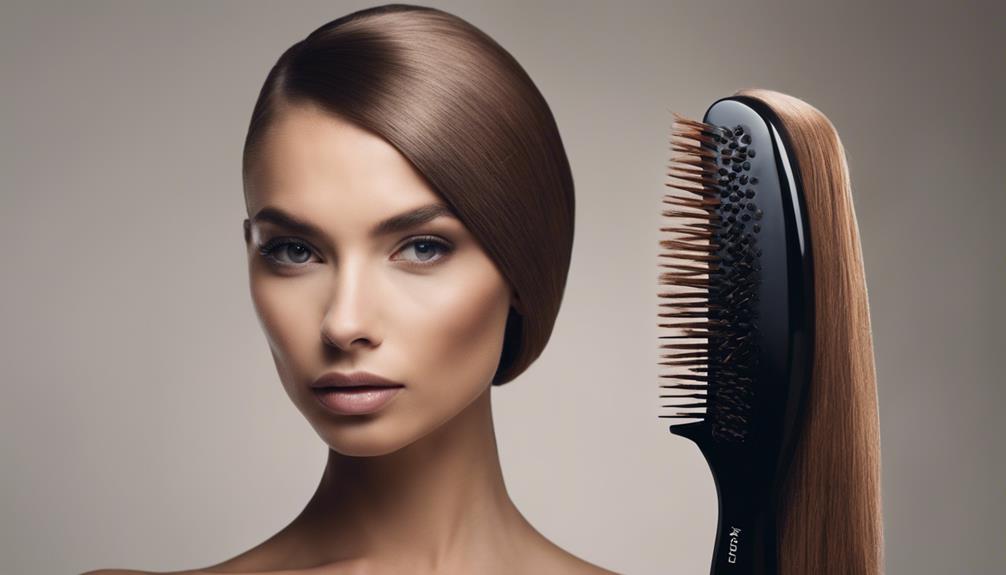
What if you could elevate your hair care routine with the right brushes? Here are some top product recommendations to contemplate.
For detangling brushes, consider the Wet Brush. Its flexible bristles make it perfect for gently removing knots from both wet and dry hair, especially if you have a sensitive scalp or tend to be tender-headed.
If you're leaning toward a styling brush, a paddle brush is an excellent choice. It features a flat surface that helps smooth your hair while blow-drying, making it ideal for preparing your locks for straightening or curling. This option works particularly well for those with thick or textured hair.
For adding volume and texture, don't overlook the teasing brush. It's designed for precise sectioning and can give your hair that extra lift at the roots. Just remember to use it sparingly to avoid damage, as it suits all hair types looking for added body.
User Experiences and Insights
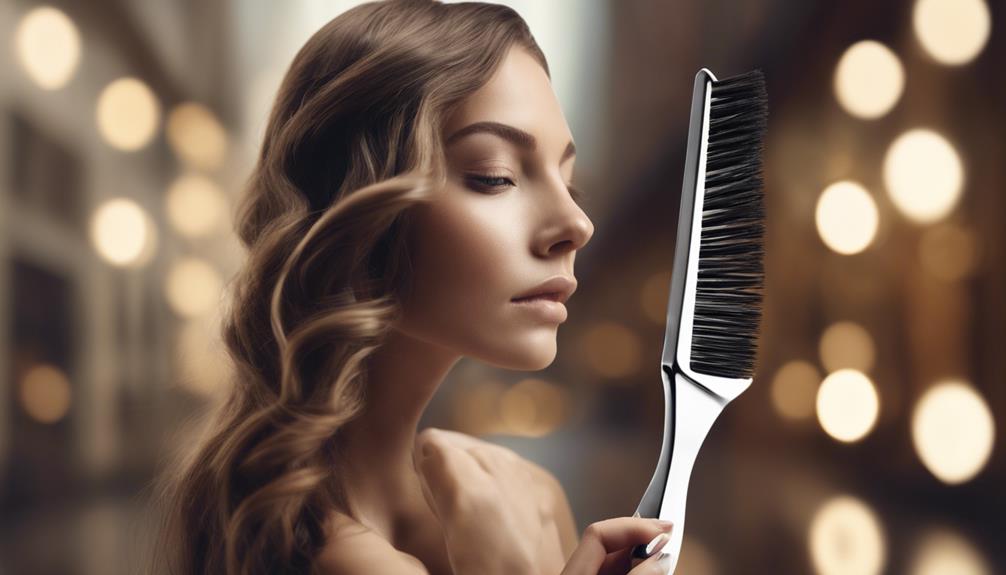
User experiences reveal how much the right brush can impact your hair care routine, with many praising the gentle design of detangling brushes like the Wet Brush for their effectiveness on tender scalps. Users consistently highlight how these brushes excel in preserving hair integrity and reducing breakage, especially for long and curly hair.
On the other hand, styling brushes, such as round brushes, are favored for their ability to create curls and volume, particularly for medium to thick hair types.
Here's what users have to say:
- Detangling brushes can be used daily without concern for damage, making them ideal for regular maintenance.
- Styling brushes offer versatility, helping achieve various hairstyles, from sleek looks to voluminous waves.
Frequently Asked Questions
What Is the Difference Between Detangling and Styling Brushes?
Detangling brushes gently remove knots without pulling, while styling brushes help shape and smooth hair during styling. You'll want a detangling brush for daily maintenance and a styling brush for creating specific hairstyles.
Are Detangling Brushes Good for Your Hair?
Yes, detangling brushes are great for your hair. Their flexible bristles minimize breakage and discomfort, allowing you to gently remove tangles without pulling, which helps maintain healthy hair and reduces split ends.
What Kind of Hair Brush Is Best for Your Hair?
Choosing the best hair brush depends on your hair type and styling needs. For detangling, use a flexible-bristled brush. For styling, opt for paddle or round brushes to achieve volume and smoothness effortlessly.
Can You Style Hair With a Detangling Brush?
You can use a detangling brush for styling, but it won't give you the polished finish you'd get from a styling brush. It's best to detangle first, then follow up with a styling brush for ideal results.
Conclusion
In the end, choosing between a detangling brush and a styling brush really depends on your hair's needs. For those with tangles and knots, a detangling brush may be the better choice. However, if your focus is more on creating a specific look or manipulating your hair, a styling brush may be the way to go. Whichever brush you choose, the ultimate goal should be keeping your hair healthy and looking its best, so it’s important to consider your hair type and the specific needs of your hair when choosing the right hairstyle.
If you think you can't use both, envision this: detangling your hair first with a gentle brush, then effortlessly styling it with your favorite one.
This combo not only saves time but also enhances your hair's health and appearance.
So, don't hesitate—invest in both brushes and enjoy the benefits they bring to your hair care routine!
